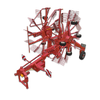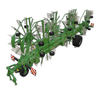Windrowers/Farming Simulator 15
A Windrower is a device designed to make collection of Mowed Grass, Dried Grass and Straw easier, by pulling together these loose substances and rearranging them into a single thin line. Collection devices like Loading Wagons and Balers will then be able to collect all of the material in one single pass, rather than several passes.
The base game offers 3 different Windrowers, which differ from one another primarily in working width.
List of Windrowers
| Windrower | Price (€) |
Maintenance (€ / day) |
Working Width (m) |
Recommended Tractor Power (kW / hp) |
|---|---|---|---|---|
| 17,000 | 40 | 8.2 | 51 / 70 | |
| 32,000 | 60 | 12.5 | 66 / 90 | |
| 75,000 | 110 | 19.0 | 96 / 130 |
Notes for Table
- Power Requirements are suggestions only.
- All Windrowers enforce a speed limit of 19 km/h while working, and they all have a Three-point hitch at the front.
Overview
When Grass is mowed, it is left behind on the ground in loose form. It usually ends up covering a very large area, after a Mower has made several (possibly non-linear) passes across a meadow or beside a road. Grass collection equipment available in the game has a very narrow working width, and will require many more passes to collect all of that loose Grass.
This is where the Windrower comes in. This device is designed to pull loose Grass from a very wide area into a single trail, which it leaves behind when it passes. If the work is done correctly, this single trail should be very easy for a collection machine to pick up in one go, instead of the many passes it would otherwise require.
Windrowers are complex machines, but they work on a very simple principle: rotating discs along the Windrower's outstretched arms scoop up the grass, and push it closer to the Windrower's central axis of motion. Wider Windrowers use several such discs, which pass the grass from one to another until it gets close to that axis. Once the grass is close to the center of the machine, it is dropped and left on the ground. This pulling-in action will take Grass from a very wide working area and condense it into a single trail.
This process can be performed on both regular Mowed Grass as well as Dried Grass (left behind after a Tedder has processed it).
Furthermore, the same principle can be applied to Straw, which is left behind Harvesters when they process fields of Wheat or Barley. Harvesters already leave narrow trails of Straw behind them, but the Windrower can combine two or more or these into a single trail. This will cut down the number of passes that will then need to be performed with a Straw collecting machine.
The narrow trail left behind the Windrower (which is called a "windrow"), can be picked up by the appropriate machine, depending on the substance, and on the preferred form you wish to pick it up as. Loading Wagons can pick up loose Grass and Straw, while Balers will pick up either substance in bale form.
Note: While it may initially seem wise to make multiple passes with the windrower, such that each windrow is stacked on top of each other to move the grass or straw from the entire field into one enormously thick windrow, so that you can simply pick it up in one swoop of another machine.... unfortunately this is not possible. The windrowers in this game, whether by design or by limitations of the engine, have a maximum amount of straw/grass they can move at a time. Attempting to move more than this in a single pass will result in the excess vanishing as if you had passed over it with a cultivator.
Windrowing Grass
Mowers tend to make tight passes back and forth across patches of Grass, and they will leave the grass lying on the ground exactly where it was cut. Therefore, a Meadow of grass will turn into a field covered entirely with loose Grass. Collection machines, having very narrow working areas, may need to make many passes to collect all of that grass.
The Windrower's primary function is to make the collection process easier by pulling all of that grass into thin, condensed lines. Instead of having to make dozens of passes, the collection machine will now need to make only a few. The wider the Windrower, the faster it can process the entire patch of grass, and the better the ratio between the size of the patch and the number of windrows that will be created.
Note that Windrowers only decrease the size of the area covered with Grass, not the amount of grass there is for pick-up. They simply condense the grass from a flat, wide sheet into a narrow, dense trail. Once you use a collecting device on this Grass, you'll notice how quickly the machine fills up. However, combining an entire field of grass into a single row, you will loose volume.
You can windrow a field of loose grass either before or after working it with a Tedder (assuming you're trying to make Hay, otherwise tedding is not necessary at all). There is little difference in the results. A Tedder passing over a windrow may spread it a little wider, but not so much that it will cause trouble during the collection process that follows.
Windrowing Straw
Harvesters working a Wheat or Barley field while its "Straw Swath" option is enabled will leave a single trail of Straw behind them on the ground. This trail is already very similar to a windrow, and is very easy to pick up.
Nonetheless, especially when working with a narrow Harvester, the field may have many of these Straw swaths on it by the time the Harvester is done working, which would require many passes with your collection machines.
A possible solution to this is to actually windrow these Straw Swaths to combine two or more of them into a single one. Therefore, for every two straw swaths or so, the collecting machine will now only need to make a single pass - cutting the work in half. Of course, this ignores the work you do with the Windrower itself, which can render this futile.
The best case to use this is when you can afford a larger Windrower, but not a larger Harvester. For example, the largest Windrower (the Krone SWADRO 2000) can collect four Straw Swaths left by the smallest Harvester (the Sampo Rosenlew Comia C6) into a single windrow - in which case the work you put in was definitely worth it.



